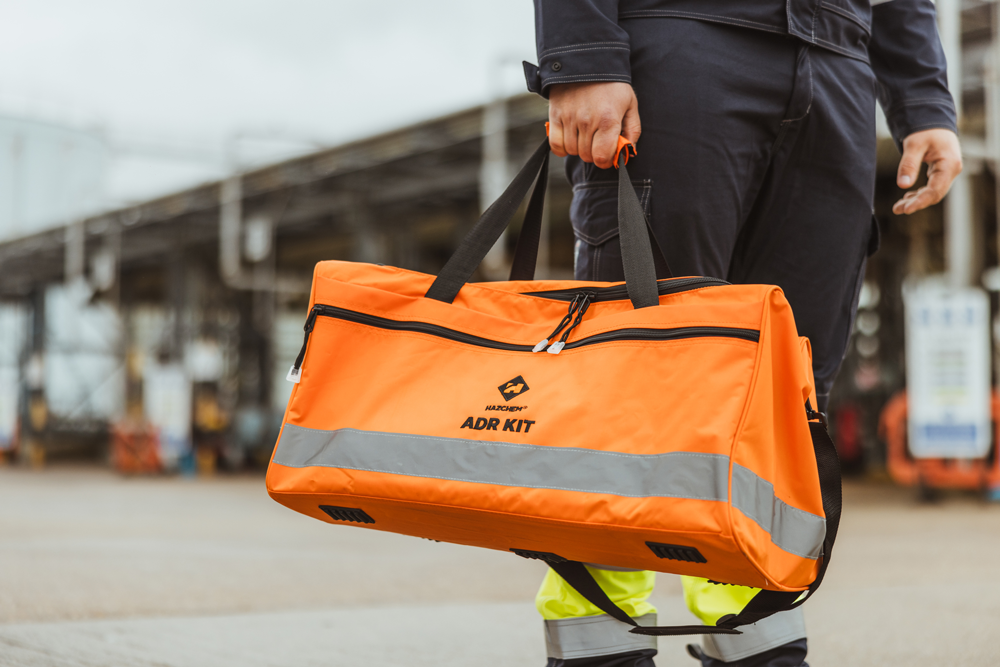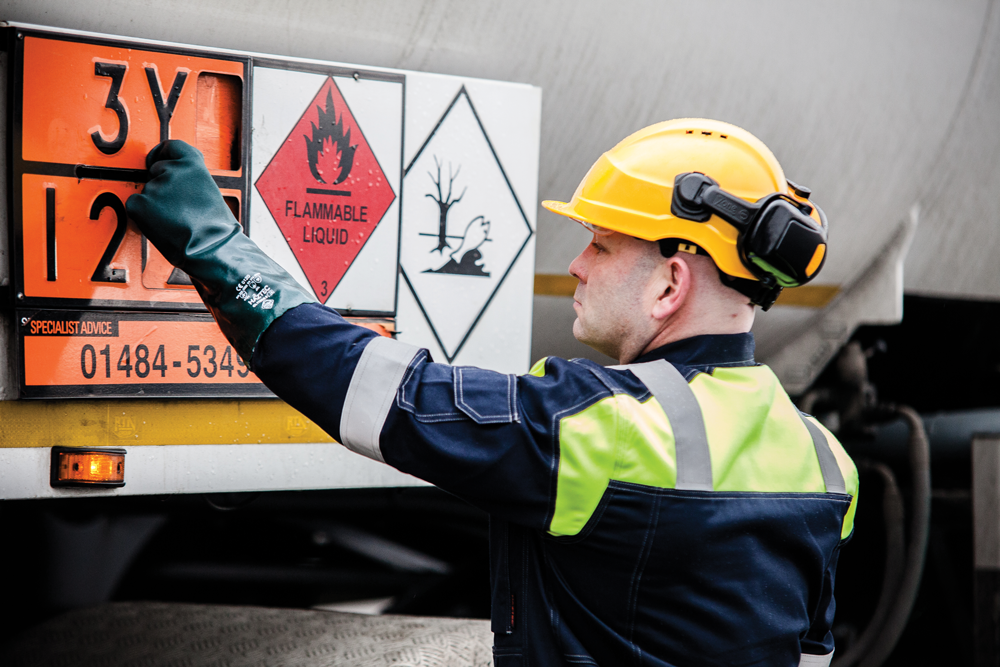What is ADR?
What Is The Definition Of ADR?

ADR stands for the European Agreement concerning the International Carriage of Dangerous Goods by Road. Originally drafted in Geneva in 1957 under the United Nations Economic Commission for Europe (UNECE), it governs how dangerous goods are transported safely across borders in Europe.
The original French name for the 1957 Treaty was:
“Accord européen relatif au transport international des marchandises Dangereuses par Route”
The most critical elements of the ADR regulations are found in Annexes A and B. Annex A outlines the provisions for the classification, packaging, labelling, and documentation of dangerous goods. Annex B focuses on the construction, equipment, and operational requirements of vehicles used to transport these goods.
Since the agreement’s inception in 1957, both annexes have been regularly amended to reflect changes in industry practices and safety standards. If you’re unsure about ADR signage or meanings, we’re here to help guide you through the requirements.
Why Are ADR Regulations Important?
The transport of dangerous goods presents serious risks, including accidents that can endanger people and property, as well as potential environmental damage. Without clear and consistent regulations, these hazards would be significantly more difficult to manage.
ADR regulations are essential to help:
- Ensure dangerous goods are properly classified, packaged, labelled and documented
- Maintain strict safety standards for the vehicles used in transport
- Equip drivers with the appropriate protective equipment and training
Without international rules, the safe and legal transport of hazardous materials across borders would be inconsistent and ultimately inefficient. Each country might apply different definitions and safety measures, creating barriers to trade and increasing the risk of non-compliance.
To support global consistency, the United Nations developed internationally recognised frameworks:
- GHS (Globally Harmonized System): Provides a standardised approach to hazard classification and labelling
- TDG (Transport of Dangerous Goods): Establishes safety requirements for all modes of transport

The ADR Agreement Explained
The core ADR agreement itself is relatively short and straightforward. One of its most integral parts is Article 2, which states that dangerous goods may be carried internationally by road, as long as they meet certain conditions, except for a few substances considered too dangerous for transport.
To be and remain compliant, two main sets of rules must be followed:
- Annex A: Covers the packaging, labelling and classification of the dangerous goods being transported.
- Annex B: Covers the construction, equipment and operation of the vehicle carrying those goods.
Since the agreement came into effect, both Annexes have been updated regularly to reflect changes in safety standards and transport practices. One major update, known as ADR 2011 (document ECE/TRANS/215, Vol. I and II), introduced a consolidated version of the agreement in line with modern international standards.
ADR is also closely aligned with other global systems, including:
- The UN Model Regulations for dangerous goods
- The International Maritime Dangerous Goods (IMDG) Code
- The Technical Instructions for Air Transport (by ICAO)
- The Rail Transport Regulations (by OTIF)
This consistency ensures that safety standards are applied across all modes of transport, not just by road.
Annex A and Annex B: The Core of ADR
The ADR agreement is built around two key sections that define how dangerous goods should be transported safely by road:
Annex A: Dangerous Goods and Handling Requirements
This annex focuses on the substances themselves and how they should be prepared for transport.
- Part 1: General provisions
- Part 2: Classification of dangerous goods
- Part 3: List of dangerous goods, special provisions, and exemptions for limited and excepted quantities
- Part 4: Packing and tank requirements
- Part 5: Consignment procedures (documentation, marking, etc)
- Part 6: Construction and testing of packaging, IBCs (Intermediate Bulk Containers), large packagings and tanks
- Part 7: Conditions for carriage, including loading, unloading and handling
Annex B: Vehicle and Transport Operation Requirements
This annex covers everything to do with the vehicle and how the transport operation is carried out.
- Part 8: Requirements for vehicle crews, safety equipment, operations, and documentation
- Part 9: Construction standards and approval procedures for vehicles
These annexes are updated regularly to stay aligned with international safety standards. Only the most recent versions, such as ADR 2019 and beyond, are valid for compliance.

ADR Vehicle Equipment
To stay compliant and safe, drivers transporting dangerous goods must carry the right equipment. There are generally two types of ADR kits available:
- Standard ADR Equipment Kit: Includes the required tools and safety items based on the class of dangerous goods being carried.
- Full ADR & PPE Kit: Offers extra personal protection for the driver in case of direct contact with hazardous substances. This full ADR kit typically includes gloves, boots, an eyewash station and a chemical suit.
View our Full Driver & PPE ADR Kit Here: DK0025 ADR Kit
Carrying a complete Hazchem ADR kit gives you peace of mind. If VOSA or the police stop you, you can quickly show that you meet the latest ADR requirements. This helps you avoid delays, penalties or being taken off the road.
Being prepared means being able to act professionally and safely in the event of an incident. With the right kit on board and the proper training, you’ll be able to protect both yourself and others.
VIEW OUR FULL RANGE OF ADR KITS

How to Stay Compliant with ADR Regulations
Staying compliant with ADR laws is essential for anyone transporting hazardous goods by road. Use this simple checklist to assess your current setup:
- Identify the class of dangerous goods you are carrying.
Each class has specific rules and may require different signage, PPE, and equipment. - Check your vehicle for the correct ADR signage and safety kit.
This includes warning placards, UN number panels, wheel chocks, fire extinguishers, and spill control materials. - Inspect all items regularly to ensure they are functional and in-date.
Pay special attention to expiry dates on fire extinguishers and PPE components.
If you are unsure what you need, Hazchem Safety offers expert advice and a full range of ADR kits, signs, and vehicle equipment. We can help you choose the right solution based on the goods you transport and the type of vehicle you use.
Trusted ADR Guidance from Industry Experts
Having the right knowledge and support is critical when transporting hazardous goods. At Hazchem Safety, we provide not just ADR kits and signage but also expert advice to help you meet legal requirements and stay fully compliant.
At Hazchem, we provide more than just products. Our team delivers:
- Personalised advice on ADR kit selection based on the class of goods and vehicle type
- Support with UK and EU compliance including training guidance and kit configuration
- Assistance in meeting inspection standards to avoid delays, fines, or penalties
We follow the most up-to-date legal standards by referencing:
- HSE for workplace responsibilities and driver safety
- GOV.UK for UK-specific exemptions and transport guidance
- UNECE for international ADR rules and updates
If you need help understanding what ADR signage, PPE, or vehicle equipment is right for your operation, our team is here to support you every step of the way.
How We Can Help You Stay ADR Compliant
Complying with ADR regulations is essential if you transport hazardous goods by road. But knowing exactly what signs, kits, or vehicle markings you need can be confusing. That’s where we come in.
Here’s how we help you make the right choices:
1. Identify the Class of Dangerous Goods
Start by confirming which class or classes of dangerous goods you are carrying.
- If you only carry one class (e.g., flammable liquids or corrosives), we offer class-specific ADR kits tailored to your load.
- If you carry mixed classes, choose a Full ADR Kit that includes all required PPE and equipment across classifications.
2. Check Your Vehicle Equipment
Next, check whether your vehicle is already fitted with essential ADR gear. Ask yourself:
- Does it have compliant dangerous goods signs?
- Are wheel chocks and fire extinguishers in place?
- Is your ADR kit complete and in date?
If you’re missing any of these items, we stock a full range of compliant ADR equipment to meet your needs.
3. Assess Vehicle Marking Requirements
Vehicle signage can vary depending on what you’re transporting. We can help you answer:
- Do I need markings on the sides of the vehicle?
- Should I display the UN code of the goods?
- Does my current signage meet the 15-minute fire resistance rule?
Our experienced team can assess your vehicle and load requirements to make sure you’re fully covered.
If you have questions, our dedicated ADR advisors are ready to walk you through every step, so you can feel confident you’re meeting all legal and safety standards.

Frequently Asked Questions
1. What products are required for ADR compliance?
For ADR road transport, drivers must carry essential safety items such as warning triangles, high-visibility clothing, wheel chocks, and fire extinguishers. Hazchem Safety offers ready-made ADR kits that meet UK and EU legal requirements.
2. Do I need different ADR equipment for different vehicle types?
Yes. The required ADR safety kit may vary depending on the vehicle type (e.g., tanker vs. van) and the class of hazardous materials being transported. Hazchem provides tailored kits for various vehicle configurations.
3. What ADR signs or labels do I need on my vehicle?
Vehicles transporting dangerous goods must display appropriate ADR placards and panel boards indicating the class and UN number of the substances. Hazchem stocks compliant signs, labels, and reflective placards.
4. How often should I inspect or replace ADR kit items?
You should regularly inspect all ADR safety equipment to ensure it’s in good condition and not expired (e.g., fire extinguishers). Hazchem offers guidance on replacement intervals and sells individual items as needed.
5. Can Hazchem Safety help me build a custom ADR kit?
Yes. We offer bespoke ADR compliance kits based on your vehicle type and the substances you transport. Contact us for personalised advice and configuration.
6. What ADR classes does Hazchem Safety support?
Our ADR solutions cover all major classes, including flammable liquids (Class 3), corrosives (Class 8), and toxic substances (Class 6.1). Our team can recommend the right PPE, signage, and spill kits for your cargo.
Ready to Get ADR Compliant?
If you’re unsure what ADR kit, signage or equipment your vehicle needs, we’re here to help. Our team specialises in ADR compliance and can recommend exactly what you need for your cargo type and vehicle setup.
- Expert guidance based on UK and EU ADR rules
- Fully compliant kits and signage for all hazard classes
- Fast, reliable delivery across the UK
Don’t leave compliance to chance.
About the Author
Brent Douglass is the Managing Director of Hazchem Safety and has led the company since 2004. With over 20 years of experience in the hazardous goods industry, Brent is passionate about protecting people and the environment in high-risk environments. His deep knowledge of ADR compliance, safety equipment, and transport regulations has made Hazchem a trusted partner for logistics and industrial businesses across the UK and Europe. Brent continues to champion high safety standards by helping companies stay compliant, equipped, and ready for the road.
